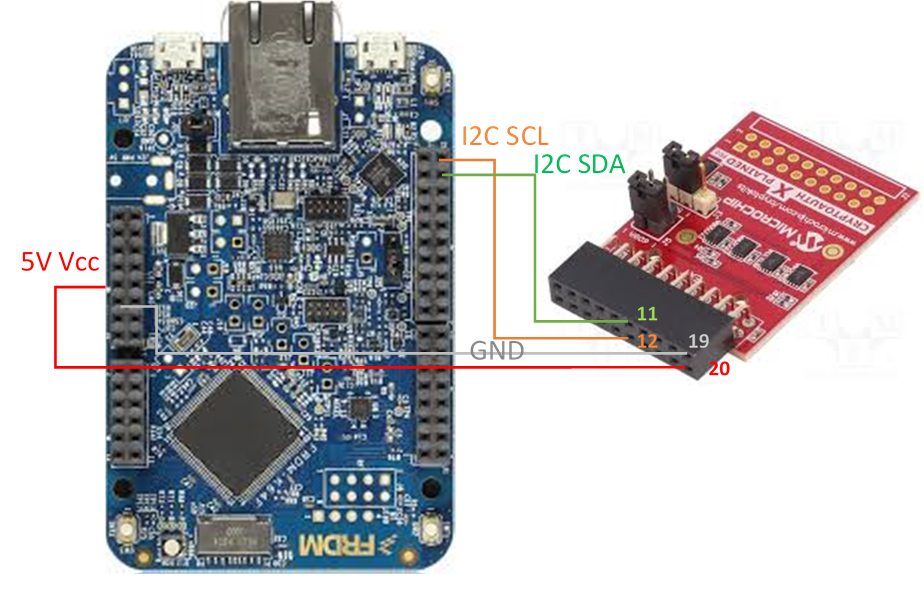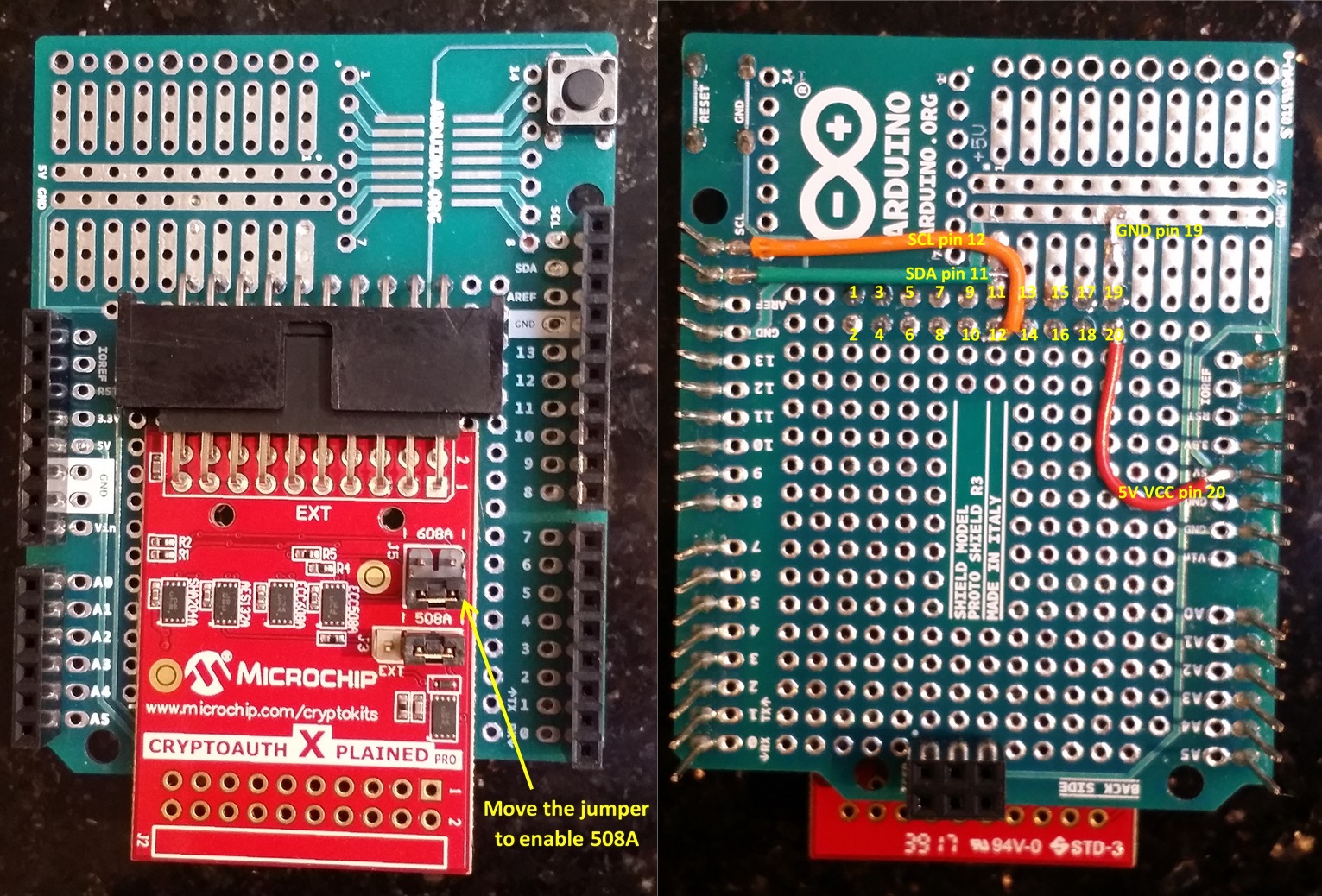Mbed OS Examples for the ATECC608A

Mbed OS Examples for the ATECC608A secure element
The examples in this repository demonstrate how to use the ATECC608A secure element with Mbed OS. The atecc608a example demonstrates use of the ATECC608A with Mbed Crypto. Examples of how to generate a certificate using pre-provisioned ATECC608A keys and how to use ATECC608A with Mbed TLS are yet to come.
Note: To see a rendered example you can import into the Arm Online Compiler, please see our quick start.
Prerequisites
A target with I2C and power supply connections, connected to an ATECC608A secure element as shown in Hardware interface.
Note: This example enables Mbed OS PSA. It is not suitable for or compatible with TF-M which has its own PSA implementation
(e.g. Arm TrustZone on Arm v8-M).
Mbed OS build tools
Mbed CLI 2
Starting with version 6.5, Mbed OS uses Mbed CLI 2. It uses Ninja as a build system, and CMake to generate the build environment and manage the build process in a compiler-independent manner. If you are working with Mbed OS version prior to 6.5 then check the section Mbed CLI 1.
1. Install Mbed CLI 2.
1. From the command-line, import the example: mbed-tools import mbed-os-example-atecc608a
1. Change the current directory to mbed-os-example-atecc608a/atecc608a.
Mbed CLI 1
- Install Mbed CLI 1.
- From the command-line, import the example:
mbed import mbed-os-example-atecc608a - Change the current directory to
mbed-os-example-atecc608a/atecc608a.
Building and running
- Connect a USB cable between the USB port on the board and the host computer.
-
Run the following command to build the example project, program the microcontroller flash memory and open a serial monitor:
- Mbed CLI 2
bash $ mbed-tools compile -m <TARGET> -t <TOOLCHAIN> --flash --sterm- Mbed CLI 1
bash $ mbed compile -m <TARGET> -t <TOOLCHAIN> --flash --sterm
Your PC may take a few minutes to compile your code.
Expected output
Serial Number:
01 23 BA CF BA D3 29 CA EE
Config zone: 01 23 BA CF 00 00 50 00 BA D3 29 CA EE C0 3D 00
C0 00 55 00 83 20 83 20 83 20 83 20 83 20 83 20
83 20 83 20 00 00 00 00 00 00 00 00 00 00 00 00
00 00 AF 8F FF FF FF FF 00 00 00 00 FF FF FF FF
00 00 00 00 FF FF FF FF FF FF FF FF FF FF FF FF
FF FF FF FF 00 00 00 00 FF FF 00 00 00 00 00 00
13 00 13 00 13 00 13 00 13 00 13 00 13 00 13 00
1C 00 10 00 10 00 10 00 10 00 10 00 10 00 1C 00
--- Device locks information ---
- Config locked: 1
- Data locked: 1
- Slot 0 locked: 0
- Slot 1 locked: 0
- Slot 2 locked: 0
- Slot 3 locked: 0
- Slot 4 locked: 0
- Slot 5 locked: 0
- Slot 6 locked: 0
- Slot 7 locked: 0
- Slot 8 locked: 0
- Slot 9 locked: 0
- Slot 10 locked: 0
- Slot 11 locked: 0
- Slot 12 locked: 0
- Slot 13 locked: 0
- Slot 14 locked: 0
- Slot 15 locked: 0
--------------------------------
Private key slot in use: 1, public: 9
Running tests...
test_hash_sha256 succesful!
test_sign_verify succesful!
test_export_import succesful!
test_psa_import_verify succesful!
test_write_read_slot succesful!
Available commands:
- info - print configuration information;
- test - run all tests on the device;
- exit - exit the interactive loop;
- generate_private[=%d] - generate a private key in a given slot (0-15),
default slot - 0.
- generate_public=%d_%d - generate a public key in a given slot
(0-15, second argument) using a private key
from a given slot (0-15, first argument);
- private_slot=%d - designate a slot to be used as a private key in tests;
- public_slot=%d - designate a slot to be used as a public key in tests;
- write_lock_config - write a hardcoded configuration to the device,
lock it;
- lock_data - lock the data zone;
Hardware interface
A couple of evaluation and development kits are available for the ATECC608A secure element.
To interface with an Mbed platform, you have to make I2C and power supply connections. Note that ATECC508A requires a 5V supply.
This is an example of how to connect an
ATCRYPTOAUTH-XPRO-B
(header)
and a K64F:

For secure connections, you can prepare a shield with ATCRYPTOAUTH-XPRO-B. Most
Mbed platforms support Arduino headers, and you can use an Arduino
shield to prepare a shield to connect ATCRYPTOAUTH-XPRO-B to an Mbed platform.
This image shows an ATCRYPTOAUTH-XPRO-B on an Arduino shield:

Note: ATCRYPTOAUTH-XPRO-B comes with ATECC508A and ATECC608A integrated circuits (ICs). Use the J5 jumper to enable ATECC508A.
License and contributions
The software is provided under Apache-2.0 license. Contributions to this project are accepted under the same license. Please see contributing.md for more info.
This project contains code from other projects. The original license text is included in those source files. They must comply with our license guide
 mbed-os-examples
mbed-os-examples